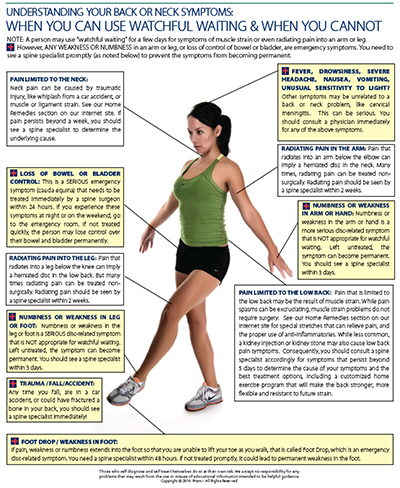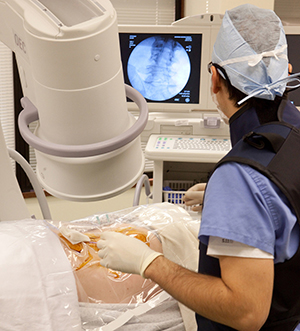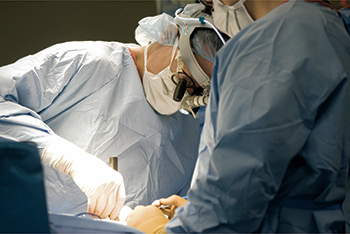Spine Center Network Credentialing Criteria
Spine Center Network staffing includes a multi-disciplinary team approach:
 Board-certified and in many cases fellowship-trained spine surgeons in orthospine or neurospine surgery.
Board-certified and in many cases fellowship-trained spine surgeons in orthospine or neurospine surgery. - Board-certified Physical Medicine & Rehabilitation specialists often fellowship-trained in interventional spine, or other non-surgical interventional anesthesiologist/pain management MDs, who provide spinal injections that can relieve pain symptoms and neurological deficit without surgery.
- Internal or affiliated spine specialized therapists with credentials and advanced training & experience in spine (e.g. McKenzie, Paris, Maitland, Cyriax, Grimsby, Mulligan, etc.) that use the spine center’s Home Remedy Book that features spine exercises and emphasizes non-surgical treatment options for back pain and neck pain. Therapist emphasis on ACTIVITY and EXERCISE instead of passive modalities (head/ice/ultrasound) that feel good but cure nothing long term.
Spine Center Network facilities include:
 Physician exam rooms for physical medicine specialists and spine surgeons to collaborate under one roof for coordination of care and improved communication about a patient’s case.
Physician exam rooms for physical medicine specialists and spine surgeons to collaborate under one roof for coordination of care and improved communication about a patient’s case.- Internal X-ray and access to MRI, CT and other diagnostic capabilities.
- Internal or affiliated spine therapists emphasizing active therapy with an exercise gym.
- Internal injection suite or injection procedure suite within an ASC environment for patient convenience.
- Use of Ambulatory Surgery Centers where possible to lower hospitalization costs, increase patient convenience, lessen time in the hospital with many patients having surgery and able to return home the same day.
Patient education requirements:
- Use of the Prizm 36-page Home Exercise Book which includes:
 Symptom Chart on emergent neurological deficit and advising back or neck pain sufferers when watchful waiting can and cannot be used.
Symptom Chart on emergent neurological deficit and advising back or neck pain sufferers when watchful waiting can and cannot be used.- Cautionary advice on exploring nonsurgical treatment options in advance of surgery.
- How to use ice and heat correctly as a home remedy.
- Cautonary advice on use of drugs to mask pain symptoms, correct use of anti-inflammatories.
- Overview on how special stretches relieve pain symptoms from strain or herniated discs
- 32 pages with 28 individual back and neck stretches covering EXTENSION, FLEXION, ROTATION and STRENGTHENING for pain relief and reduction in risk of future back pain attacks.
- Education on how to lift correctly to reduce incidence of back strain.
- Benefit of walking to relieve back and neck pain.
 Use of a content-rich educational Internet site with symptom charts, home remedies & exercises to make back pain sufferers well-informed healthcare consumers, and less likely to doctor shop for unnecessary procedures and surgeries. If surgery is necessary, patient education emphasis to pursue a minimally invasive spine surgery approach.
Use of a content-rich educational Internet site with symptom charts, home remedies & exercises to make back pain sufferers well-informed healthcare consumers, and less likely to doctor shop for unnecessary procedures and surgeries. If surgery is necessary, patient education emphasis to pursue a minimally invasive spine surgery approach.
Patient satisfaction & Clinical Outcomes
- Use of surveys to track patient satisfaction after physician visits.
- Use of intake assessments to audit patient severity of new patients.
 Willingness to track clinical outcomes, e.g. patient severity at intake, use of drugs pre & post treatment, use of injections, use of surgery and metrics that track functional status pre and post treatment on a Clinical Outcome Report Card.
Willingness to track clinical outcomes, e.g. patient severity at intake, use of drugs pre & post treatment, use of injections, use of surgery and metrics that track functional status pre and post treatment on a Clinical Outcome Report Card.
Spine center philosophy of care:
- Emphasis on nonsurgical treatment options (spinal injections to reduce inflammation, spine therapy) in advance of spine surgery.
- If surgery is necessary, use of minimally invasive spine surgery techniques (e.g. tubular retractors the width of a ballpoint pen that lessen incision size from 3 inches to 1 inch) and instrumentation to reduce hospital stay and speed return to activity with a less painful recovery.
 Use of the most advanced motion preservation options, e.g. artificial disc in the cervical spine to reduce adjacent segment disease.
Use of the most advanced motion preservation options, e.g. artificial disc in the cervical spine to reduce adjacent segment disease.- Willingness to explore value-based bundled rates for spine care.
- Participation in local payor and employer networks and their spine criteria. For example, some of these spine centers have already been designated by health insurance companies as having met their criteria for a spine center of excellence. Other networks require patients to have a referral from the PM&R physician to see a spine surgeon.
Spine Centers of Excellence
 Board-certified and in many cases fellowship-trained spine surgeons in orthospine or neurospine surgery.
Board-certified and in many cases fellowship-trained spine surgeons in orthospine or neurospine surgery.  Physician exam rooms for physical medicine specialists and spine surgeons to collaborate under one roof for coordination of care and improved communication about a patient’s case.
Physician exam rooms for physical medicine specialists and spine surgeons to collaborate under one roof for coordination of care and improved communication about a patient’s case. Symptom Chart on emergent neurological deficit and advising back or neck pain sufferers when watchful waiting can and cannot be used.
Symptom Chart on emergent neurological deficit and advising back or neck pain sufferers when watchful waiting can and cannot be used. Use of a content-rich educational Internet site with symptom charts, home remedies & exercises to make back pain sufferers well-informed healthcare consumers, and less likely to doctor shop for unnecessary procedures and surgeries. If surgery is necessary, patient education emphasis to pursue a minimally invasive spine surgery approach.
Use of a content-rich educational Internet site with symptom charts, home remedies & exercises to make back pain sufferers well-informed healthcare consumers, and less likely to doctor shop for unnecessary procedures and surgeries. If surgery is necessary, patient education emphasis to pursue a minimally invasive spine surgery approach. Willingness to track clinical outcomes, e.g. patient severity at intake, use of drugs pre & post treatment, use of injections, use of surgery and metrics that track functional status pre and post treatment on a Clinical Outcome Report Card.
Willingness to track clinical outcomes, e.g. patient severity at intake, use of drugs pre & post treatment, use of injections, use of surgery and metrics that track functional status pre and post treatment on a Clinical Outcome Report Card.  Use of the most advanced motion preservation options, e.g. artificial disc in the cervical spine to reduce adjacent segment disease.
Use of the most advanced motion preservation options, e.g. artificial disc in the cervical spine to reduce adjacent segment disease.